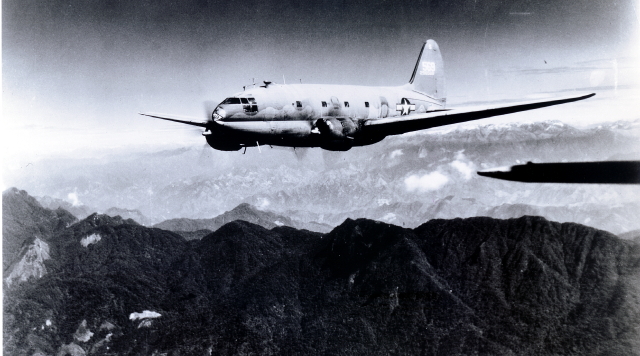
The Hump
America’s Strategy for Keeping
China in World War II
By John D. Plating. 320 pp.
Texas A&M Press, 2011. $34.95.
“The Hump” was slang for the daunting airlift route from India across the Himalaya Mountains to China. The term evoked the threatening mass of jagged towering peaks, but the vicissitudes of weather and the lack of emergency landing fields also contributed to its evil reputation. By the war’s end, the route was paved with “an aluminum trail,” the wreckage of 594 aircraft in which 910 American airmen perished.
Author John D. Plating, an air force officer and former transport pilot, has written not only a first-rate history, but the first truly comprehensive examination of the 1942–45 efforts to maintain an aerial supply channel to China. When the Japanese conquest of Southeast Asia and Burma snapped the last overland routes, President Franklin D. Roosevelt pledged to Generalissimo Chiang Kai-Shek that the U.S. would continue to support China via an airlift.
Those looking for colorful personal accounts of exhilarating adventures should look elsewhere. Plating’s richly researched and rewarding pages do not neglect the experiences of the flight crews, but locate them within a vast tapestry of global and theater strategies, logistics, and politics, as well as operational nuts and bolts encompassing aircraft, personnel, weather, and command. He displays a mastery of the many-layered agendas of British, American, and Chinese actors in the drama. For example, a major early impediment arose from the lack of focus and resources British colonial authorities in India brought to airfield construction, moving supplies to the airfields, and providing workers to load the aircraft. American air crews arrived often grossly underprepared for the Hump’s challenges, and soon displayed an alarming (and sometimes fatal) urgency about acquiring the number of flight hours needed to qualify for rotation home. As one shrewd American naval attaché pointed out, the Hump served American strategy not just as material support for our main Asian ally but as the symbol of moral commitment to them. Though seldom remembered today in America, this chapter of the war still claims an honored place in Chinese schoolbooks.
From pitiful monthly figures in 1942, when the delivery of 400 tons represented a breakthrough, increasing resources and vastly improved efficiency (produced in substantial measure by commissioned American airline executives) translated into 10,000 tons in December 1943, which soared to 70,000 tons in July 1945. By then, the Hump engaged nearly 750 planes and 4,000 pilots. When the long-delayed and costly land campaigns permitted reopening a surface link to India in January 1945, logisticians calculated that the airlift was actually more cost effective than the truck route for delivering supplies. But Chiang’s ground forces in China received only about three of every hundred pounds delivered. Lieutenant General Claire Chennault’s airmen in China, General Joseph Stilwell’s program to outfit a fraction of Chiang’s soldiers, and the ill-conceived basing of a B-29 wing in China bitterly competed for the rest.
There are a handful of typos as well as the rare misstatement or two here, but this reviewer’s only modest reservation concerns Chiang. Although Plating acknowledges the many broken American promises to the Chinese Nationalist leader, he draws mostly from highly critical scholarship. Over the last decade, however, there has been a significant shift, particularly in the works of Jay Taylor and Hans J. van de Ven, which acknowledge Chiang’s manifest flaws and foibles but also tender a more sympathetic portrait




